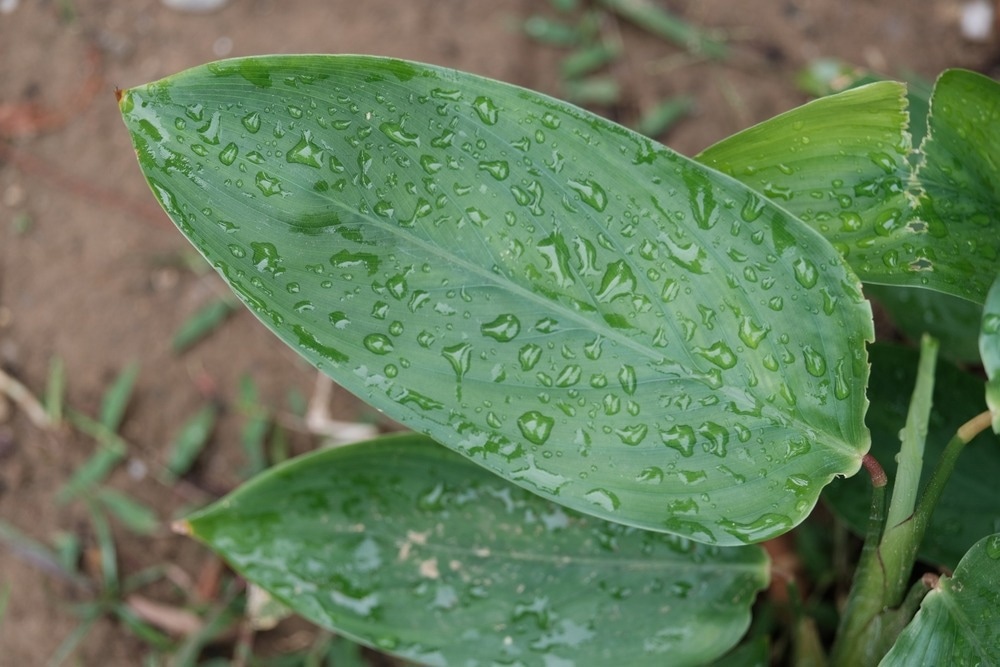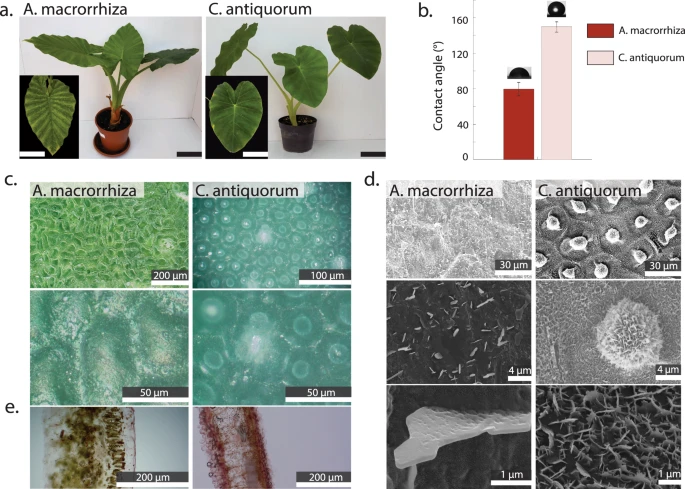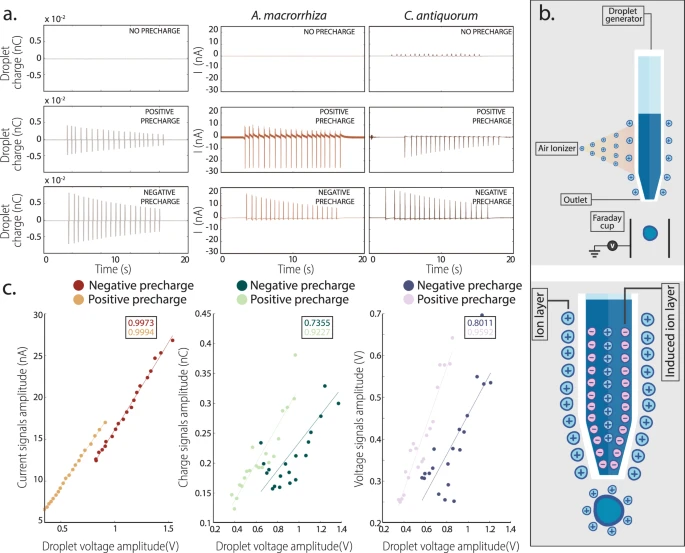 By Surbhi JainReviewed by Susha Cheriyedath, M.Sc.Oct 27 2022
By Surbhi JainReviewed by Susha Cheriyedath, M.Sc.Oct 27 2022In an article recently published in the open-access journal Communication Materials, researchers discussed liquid-solid interaction that electrifies when water droplets meet living plant leaves.

Study: Liquid-solid contact electrification when water droplets hit living plant leaves. Image Credit: Muksalmina Fadri/Shutterstock.com
Background
The greatest biointerface is found on the exterior of living plants, particularly leaves. Some plants developed leaf surfaces with superhydrophobic and self-cleaning properties in response to the water droplet-leaf collision or the well-known Lotus effect. Recently, it was demonstrated that contact electrification may also convert mechanical solid-solid impacts on leaves into electricity.
This generates currents that can be captured and utilized to power low-power commercial devices, depending on the materials that come into contact with the leaf. Utilizing the living plant as a component of the gadget, similar outcomes have been obtained. On artificial materials, the mechanism of liquid-solid triboelectrification has recently been clarified by several experimental works.
Similar to how solid-solid triboelectrification was successfully converted into triboelectric nanogenerators (TENGs), liquid-solid triboelectrification also achieved this. It has also been demonstrated that water droplets on living leaves and materials produced by plants can emit electrical impulses. This necessitates adding more electrodes for the droplet to land on.
Making artificial triboelectric nanogenerators with greater performance has been made possible by drawing inspiration from the micro/nanostructure of leaves. The numerous elements available in plants can lead to distinct charge patterns, while lignin components have completely different behavior. As a result, more knowledge is needed on how contact charging happens in nature. It is yet unknown how liquid-contact electricity develops on the layered, in-situ leaf surface.

Characteristics of model species A. macrorrhiza and C. antiquorum. a Photographs of A. macrorrhiza and C. antiquorum, insets are top view images of the leaves. All scale bars are 10 cm. b Water contact angle of both species measured at 0° inclination. Mean and standard deviation of five measurements is given. c Digital microscopy of the adaxial side of the living leaf showing the surface and epidermal cellular structure. d SEM images of the adaxial leaf side at different magnifications showing the different distribution and density of surface wax crystals on both species. e Microscopy of leaf cross-sections of A. macrorrhiza and C. antiquorum and the cuticle specifically stained in red (using Sudan IV). The stronger red color of C. antiquorum samples qualitatively confirm the larger number of stained waxes. Image Credit: Armiento, S et al., Communication Materials
About the Study
In this study, the authors demonstrated how numerous superhydrophobic and hydrophilic living plant species' liquid-solid contact electrification was influenced by droplet ionization, droplet composition, and in-situ leaf surface structures. It was discovered that the Lotus effect's hierarchical structures caused self-cleaning and wetting and also produced a particular electrification pattern. Depending on the structure and content of the epicuticular wax layer as well as the composition of the water droplet, each water drop created a distinctive signal in the plant tissue. These discoveries shed light on the process of contact electrification in nature and raised the possibility of developing novel bio-based materials for energy storage and sensing in man-made and plant-hybrid systems.
The team looked into how the structural and wetting characteristics of leaves affected liquid-solid contact electrification in living plants. The most common plant species used in tests were Alocasia macrorhiza and Colocasia antiquorum. Two species from the same genus Araceae shared similar characteristics, while A. macrorrhiza was hydrophilic, and C. antiquorum was water-repellent. Comparing the electrification of leaves caused by water droplets indicated that even while superhydrophobic species had a low attraction for the water droplet, the electrification caused by water contact was considerably amplified.
The researchers clarified the role of the wax layer in the electrification of liquid-solid contact by the selective removal of the epicuticular waxes and treatments that altered their nanostructure. Other hydrophilic and superhydrophobic plants, as well as synthetic materials like fluorinated polymers, were compared to confirm the effect. The parameters that influence liquid-solid contact electrification on living leaves were determined by experiments employing artificially pre-charged droplets of water and solutions with different pH and ion concentrations.

Effect of droplet pre-charging on the signals generated in A. macrorrhiza and C. antiquorum. a Table of graphs showing the droplet charge before leaf impact (first column), current signals measured in A. macrorrhiza (second column) and C. antiquorum (third column). The first row corresponds to no pre-charge condition, the second to positive pre-charge and the third to negative pre-charge. Each electrical variable was measured thrice per leaf, for a total of 60 droplets and signals; results of 20 droplets are representatively shown. b Schematics showing the setup (upper panel) and the mechanism (lower panel) of droplet pre-charging by pipette ionization. c Scatter plots illustrating the relationship between the droplet signal in the Faraday cup and the current, charge, and voltage amplitudes in C. antiquorum. Each point corresponds to a single droplet impact in a series of twenty sequential impacts. The insets give the correlation coefficients between the droplet voltage signal measured in the Faraday cup and the corresponding current, charge or voltage; a linear fit for each set is included. Image Credit: Armiento, S et al., Communication Materials
Observations
At all pHs, a solution of 1 M NaCl caused the signals to change polarity. The fact that both electron and ion transport could contribute to signal creation provided one explanation for polarity switching. The voltage and current peaks associated with single raindrop impingements were up to 0.2 ± 0.02 V and 2 ± 0.2 nA, respectively, and were equivalent to 0.4 nW of peak power. The peak length of the current was around 60 ms at full width at half maximum (FWHM).
The pH had an impact on the signals' loudness. Signals were greatly diminished at pH 3, whereas basic pH had no discernible effect. The pH affected the electrification of the liquid-solid contact. It was demonstrated that exposure to pH 3 could harm the epicuticular wax layer, causing it to appear melted.
In tests with wax layers removed from C. antiquorum, hydrophobic behavior persisted, but signals were weak and resembled those of hydrophilic plants. The findings unmistakably showed that the wax layer was crucial to the production of signals and that eliminating waxes had a greater impact on signals. The signals decreased even though the treated leaves still had contact angles of about 120 ° and were hydrophobic, suggesting that hydrophobicity might not be the primary factor in signal production. The generated voltage signals brought on by deionized water droplets were drastically reduced when the epicuticular wax layer was removed, going from a current amplitude of roughly 1 nA to peaks of 0.1 nA.
The signals were reduced by nearly two times to an average amplitude of 0.5 nA simply by melting the waxes and altering the nanostructure to a flatter epicuticular wax layer. A reduction of the vibrations at 1460 cm-1, 719 cm-1, and 1470 cm-1, which correlated to structures found in the cutin and the waxes, was observed in Fourier transform infrared (FTIR) tests made before and after wax removal.
Furthermore, compared to the immaculate leaf, both the melting and removal of the epicuticular wax resulted in a 30° reduction in the contact angle. The droplet interaction with the treated leaf surfaces remained hydrophobic and not comparable to that of the hydrophilic A. macrorrhiza leaf, despite the high contact angle remaining at 120°.

Effect of liquid’s monovalent ion concentration and pH on electric signals generated after contact with C. antiquorum. a Boxplot showing the effect of NaCl concentration on the generated current amplitude. Each box represents 50 measurements recorded after previously 3000 droplets of the same solution have been dropped on the leaf. b Effect of pH on the generated current amplitude. The boxplot summarize 20 droplet impacts on C. antiquorum leaves for each ion concentration and pH, respectively. Image Credit: Armiento, S et al., Communication Materials
When 1 M NaCl was utilized at various pH levels, no discernible variation was observed, indicating that the influence of the pH in these circumstances was determined by the ion concentration. A. macrorrhiza produced just 0.1 nA and C. antiquorum up to 2 nA current peaks while using uncharged water droplets.
Conclusions
In conclusion, this study elucidated that each droplet impact produced a distinctive electrical signal in the tissue, especially on superhydrophobic plants, utilizing a live, bare plant with no other parts other than a single electrode implanted in the stem. The findings showed the essential impact of leaf epicuticular waxes on droplet ion concentration, pH, and signal production. Contact electrification resulted in signals when droplets were uncharged and had low ion concentrations, and signals were stronger on thickly wax-coated superhydrophobic plants.
The authors mentioned that the findings presented in this work provided previously unattainable insight into an occurrence that takes place every time a raindrop contacts a leaf and are crucial to comprehending liquid-solid contact electrification on intricate surfaces in living creatures. They stated that the findings could also be used to create a new generation of plant-hybrid devices that focus on environmentally friendly, sustainable technologies for monitoring ecosystem health and status.
More from AZoM: Self-Cleaning, Dirt-Repellent and Degradable Bioplastics
References
Armiento, S., Filippeschi, C., Meder, F., et al. Liquid-solid contact electrification when water droplets hit living plant leaves. Communication Materials, 3, 79 (2022). https://www.nature.com/articles/s43246-022-00302-x
Disclaimer: The views expressed here are those of the author expressed in their private capacity and do not necessarily represent the views of AZoM.com Limited T/A AZoNetwork the owner and operator of this website. This disclaimer forms part of the Terms and conditions of use of this website.